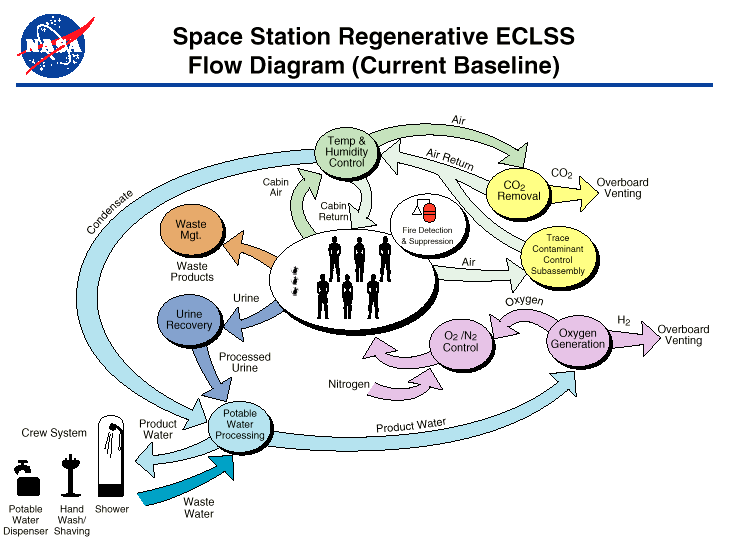Difference between revisions of "Life support system" - New World Encyclopedia
(imported latest version of article from Wikipedia) |
(added credit and category tags, deleted foreign language links) |
||
| Line 100: | Line 100: | ||
* [http://oregonstate.edu/~atwaterj/als_mars.htm Publications on Mars Life Support Systems] | * [http://oregonstate.edu/~atwaterj/als_mars.htm Publications on Mars Life Support Systems] | ||
| − | [[Category: | + | [[Category:Physical sciences]] |
| − | [[Category: | + | [[Category:Aerospace technology]] |
| + | [[Category:Space exploration]] | ||
| − | + | {{credit|256113737}} | |
| − | |||
| − | |||
| − | |||
| − | |||
| − | |||
| − | |||
| − | |||
| − | |||
Revision as of 17:00, 5 January 2009
- For other uses of "Life support", see Life support (disambiguation).
In human spaceflight, the life support system is a group of devices that allow a human being to survive in outer space. NASA often uses the phrase Environmental Control and Life Support System or the acronym ECLSS when describing these systems for its human spaceflight missions.[1] The life support system may supply: air, water and food. It must also maintain the correct body temperature, an acceptable pressure on the body and deal with the body's waste products. Shielding against harmful external influences such as radiation and micro-meteorites may also be necessary. Components of the life support system are life-critical, and are designed and constructed using safety engineering techniques.
Life support functions
Human physiological & metabolic needs
A crewmember of typical size requires approximately 5 kg (total) of food, water, and oxygen per day to perform the standard activities on a space mission, and outputs a similar amount in the form of waste solids, waste liquids, and carbon dioxide.[2] The mass breakdown of these metabolic parameters is as follows: 0.84 kg of oxygen, 0.62 kg of food, and 3.52 kg of water consumed, converted through the body's physiological processes to 0.11 kg of solid wastes, 3.87 kg of liquid wastes, and 1.00 kg of carbon dioxide produced. These levels can vary due to activity level, specific to mission assignment, but will correlate to the principles of mass balance. Actual water use during space missions is typically double the specified values mainly due to non-biological use (i.e. personal cleanliness). Additionally, the volume and variety of waste products varies with mission duration to include hair, finger nails, skin flaking, and other biological wastes in missions exceeding one week in length. Other environmental considerations such as radiation, gravity, noise, vibration, and lighting also factor into human physiological response in space, though not with the more immediate effect that the metabolic parameters have.
Atmosphere
Space life support systems provide atmospheres composed primarily of oxygen, nitrogen, water, carbon dioxide, and other trace gases. The partial pressures of each component gas additively combine to the overall barometric pressure, typically 101.3 kPa (Earth standard atmospheric pressure at sea-level). However, atmospheric pressure can be significantly lower (25-26 kPa for EVAs) given a corresponding increase in the partial pressure of oxygen. Lower atmospheric pressures are advantageous for designing spacecraft with less structural mass and reduced atmospheric loss. The two primary ways of achieving this are by reducing atmospheric pressure while keeping the percent of oxygen the same (~21%) or through allowing the oxygen concentration to remain at sea-level pressure while reducing the overall barometric pressure.
Temperature control
Water
Water is consumed by crewmembers through drinking, cleaning activities, EVA thermal control, and emergency uses. It must be stored, used, and reclaimed (from waste water) efficiently since no in-situ sources currently exist for the environments reached in the course of human space exploration.
Food
Life support systems often include an indoor plant cultivation system which allows food to be grown within buildings and/or vessels. Often, the system is designed so that it reuses all (otherwise lost) nutrients. This is done in practice by for example composting toilets so which reintegrate waste material (excrement) back into the system by allowing the nutrients to be taken up by the food crops. The food coming from the crops is then consumed again by the system's users and the cycle continues.
Waste
Microbe detection and control
The NASA LOCAD (Lab-on-a-Chip Applications Development) project is working on systems to help detect bacterial and fungal growths in spacecraft used for long-duration spaceflight.[3]
Space vehicle systems
Gemini, Mercury, & Apollo
Space Shuttle
For the Space Shuttle, NASA includes in the ECLSS category systems that provide both life support for the crew and environmental control for payloads. The Shuttle Reference Manual contains ECLSS sections on: Crew Compartment Cabin Pressurization, Cabin Air Revitalization, Water Coolant Loop System, Active Thermal Control System, Supply and Waste Water, Waste Collection System, Waste Water Tank, Airlock Support, Extravehicular Mobility Units, Crew Altitude Protection System, and Radioisotope Thermoelectric Generator Cooling and Gaseous Nitrogen Purge for Payloads.[4]
Orion Crew Module
The Orion crew module life support system is being designed by Lockheed Martin in Houston, Texas.
Soyuz
The life support system on the Soyuz spacecraft is called the Kompleks Sredstv Obespecheniya Zhiznideyatelnosti (KSOZh).
